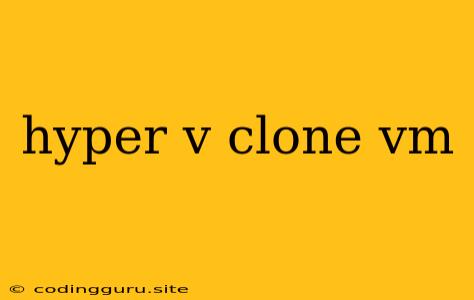Hyper-V: How to Clone a Virtual Machine for Efficient Management and Deployment
Hyper-V, Microsoft's virtualization platform, offers a powerful solution for creating and managing virtual machines (VMs). One key benefit of Hyper-V is its ability to clone VMs, which simplifies tasks like deploying identical systems, testing new software, or creating backup copies.
Why Clone a Hyper-V Virtual Machine?
Cloning a VM in Hyper-V offers several advantages:
- Rapid Deployment: Quickly provision new virtual machines based on an existing template, saving time and effort.
- Consistency: Ensure that multiple VMs have identical configurations, reducing the risk of configuration errors.
- Testing Environments: Create isolated environments for testing updates, patches, or new applications without affecting production systems.
- Backups: Regularly clone your critical VMs for disaster recovery purposes.
Methods for Cloning a Hyper-V Virtual Machine
There are two primary methods for cloning VMs in Hyper-V:
1. Using the Hyper-V Manager Interface:
This method involves using the built-in tools within the Hyper-V Manager console.
-
Steps:
- Open Hyper-V Manager.
- Right-click on the source VM you want to clone and select "Export".
- Choose a location to save the export file.
- Once the export is complete, right-click within Hyper-V Manager and select "Import Virtual Machine".
- Select the exported file and provide a name for the new VM.
- Choose the appropriate settings for the cloned VM.
-
Pros: Simple and intuitive, suitable for basic cloning tasks.
-
Cons: May not be suitable for more complex cloning scenarios, such as copying data from the source VM to the clone.
2. Using PowerShell Cmdlets:
PowerShell offers more advanced options for cloning VMs, providing flexibility and automation capabilities.
-
Steps:
- Open Windows PowerShell with administrator privileges.
- Use the
Export-VMcmdlet to create an export file of the source VM. - Use the
Import-VMcmdlet to import the export file and create the cloned VM. - You can use additional parameters like
CopyVirtualHardDiskto control the copying of virtual hard disks. - Customize the cloned VM's settings using
Set-VMcmdlets.
-
Pros: Offers advanced control, automation, and integration with scripts.
-
Cons: Requires PowerShell scripting knowledge.
Tips for Efficient Hyper-V VM Cloning:
- Optimize Export and Import Paths: Choose efficient storage locations for export files and imported VMs to minimize transfer times.
- Use a Dedicated Storage: Consider using dedicated storage for VM backups and clones to prevent performance impacts on production systems.
- Test Clones Thoroughly: Always test cloned VMs after the process to ensure functionality and proper configuration.
Example: Cloning a Hyper-V VM with PowerShell
# Export the source VM
Export-VM -Name "SourceVM" -Path "C:\VMExports\SourceVM.vhdx"
# Import the exported VM
Import-VM -Path "C:\VMExports\SourceVM.vhdx" -Name "CloneVM"
# Copy the virtual hard disk to a new location
Copy-VMHardDisk -Path "C:\VMExports\SourceVM.vhdx" -DestinationPath "D:\VMClones\CloneVM.vhdx"
# Customize the cloned VM settings
Set-VM -Name "CloneVM" -MemoryStartupBytes 8GB -ProcessorCount 2
# Start the cloned VM
Start-VM -Name "CloneVM"
Conclusion
Cloning virtual machines in Hyper-V is a valuable technique for simplifying deployments, testing, and backup strategies. By leveraging either the graphical interface or PowerShell cmdlets, you can efficiently create clones of your VMs, ensuring consistency and saving valuable time. Remember to test your clones thoroughly to ensure they are operational and configured as expected.
